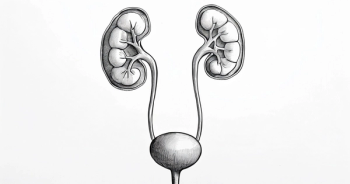
Case Review: Metastatic Renal Cell Carcinoma
Robert J. Motzer, MD:This is a 49-year-old male who was previously healthy, and he presented to an emergency room with complaints of abdominal pain. He had an evaluation done by CT scan in the emergency room that showed that he had diverticulitis, which was likely the cause of the abdominal pain, but he was found to have an 8-centimeter left renal mass, that was found incidentally. The patient was referred to a urologist and had a complete workup, which included a CT scan of his chest, abdomen, and pelvis, appropriate blood work and a urinalysis, and he underwent a left radical nephrectomy.
The left radical nephrectomy was performed in September 2015, and the results showed that this was a clear cell carcinoma, a stage T2a. The Fuhrman grade was 3, and a node dissection showed that there was no spread to the nodes. At that point, CT imaging of the chest showed no evidence of metastasis and he was considered to have stage 2 clear cell carcinoma of the kidney.
The patient was followed with serial imaging studies by the urologist, and in September 2017, was noted to have a local recurrence in the bed at the site of the nephrectomy, as well as a large lytic metastasis in his pubic bone. Further imaging showed multiple pulmonary metastasis. He was referred to a medical oncologist who continued the evaluation, and blood work performance status, and other serologic tests showed that the patient was anemic, had normal calcium, had an adequate performance status of 90, and was considered to be intermediate risk by both MSKCC and international criteria.
The medical oncologist started the patient on sunitinib on the standard 4-week on, 2-week off schedule. He tolerated therapy relatively well, initially having hypertension, which required implementation of antihypertensives. He also had some hand-foot skin reaction, which was managed by topical lubricants.
The patient achieved a partial response to sunitinib with a stable bone disease, but good response in both the lung metastasis and in the local recurrence on the left kidney bed. He was continued on the sunitinib until July 2018, when he was noted to have additional pain in the pubic bone. The imaging on treatment with sunitinib, showed that he had progression in the bone, a retroperitoneal mass, and new lung metastasis as well.
At that point the medical oncologist restaged the patient with a full CT scanchest, abdomen, and pelvis—with appropriate blood work, and he was deemed to be intermediate risk by MSKCC criteria, based on anemia but with normal calcium, and a performance status at that time of 80. There were several treatment options that were considered at the time, including axitinib, nivolumab, and cabozantinib. The treating oncologist chose lenvatinib/everolimus and initiated systemic therapy with those agents at that time, as a second-line treatment.
Transcript edited for clarity.
A Japanese-American Male With Recurrent RCC
November 2015
- At the age of 49, a Japanese-American man presented to the ER with abdominal pains
- CT of the abdomen and pelvis revealed diverticulitis with an incidental left renal mass (4.2 cm × 8.6 cm × 2.8 cm)
- SH: Marathon runner; nonsmoker; social drinker
- He underwent sigmoid colon resection; left radical nephrectomy
- Pathology; sigmoid colon pathology revealed diverticulitis; renal pathology revealed RCC, clear cell type
- Diagnosis: RCC stage PT2a
- KPS: 90
- Fuhrman Grade: 3/4
September 2017
- Follow-up CT showed residual soft tissue in the left nephrectomy bed, pulmonary lung metastasis, and an expansile lucent osseous lesion in the right pubic ramus
- Biopsy of one of the osseous lesions confirmed mRCC
- He began systemic therapy with sunitinib for 20 weeks and achieved stable disease and some shrinkage of the bone lesion
- KPS: 90
- MSKCC risk score: Intermediate
July 2018
- The patient now complains of left pelvic pain
- Imaging shows marked progression in retroperitoneal mass; new lung metastasis
- Laboratory values:
- CBC: WBC - 7; Hgb - 12.6; Platelet - 190; ANC 5.2;
- CMP; Creatinine - 1.82 mg/dL; LFTs - WNL; Calcium - 9.2 mg/dL; LDH WNL
- MSKCC risk score: Intermediate
- KPS: 80
- The patient was treated with palliative radiation therapy to bone metastasis
- He was then started on treatment with lenvatinib/everolimus







































